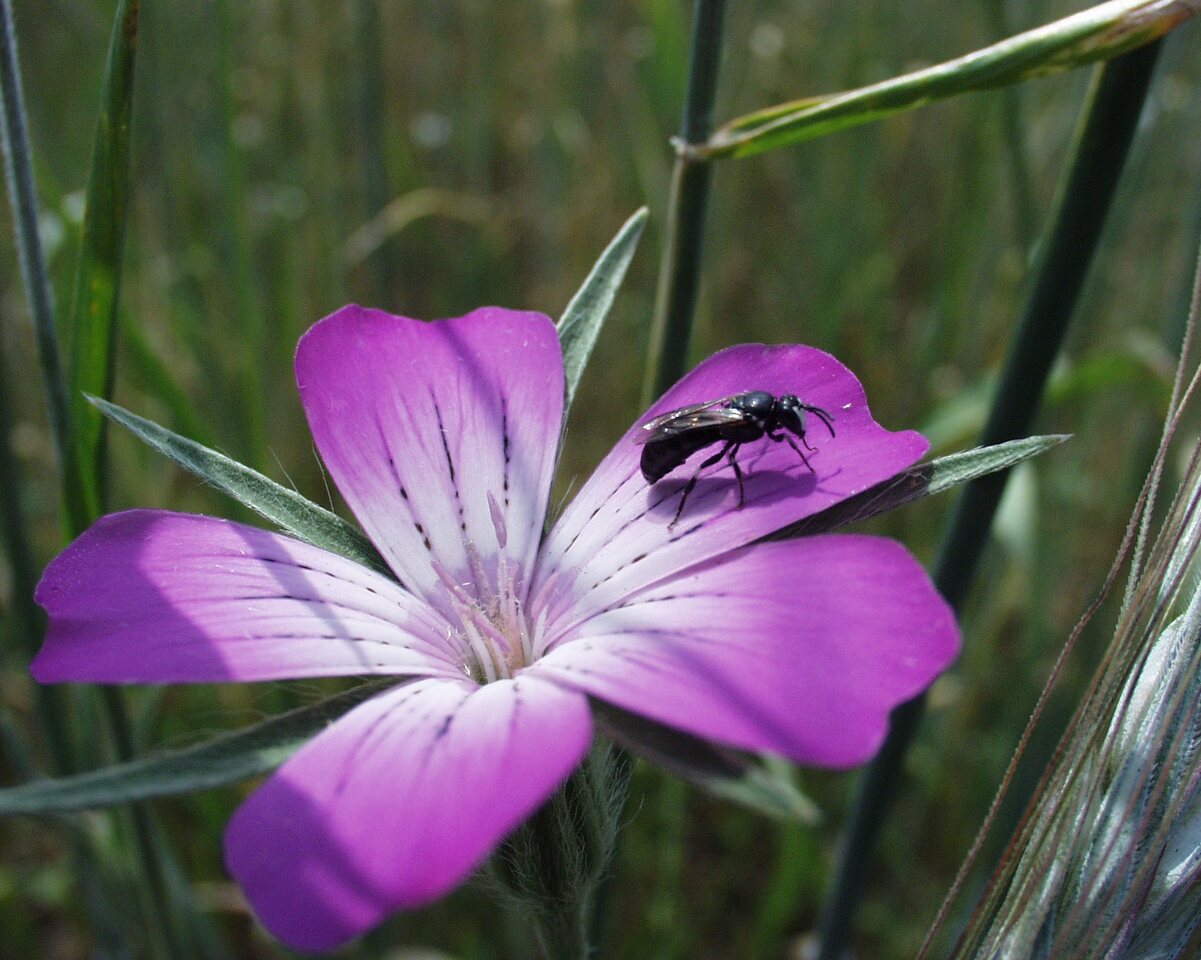
Agrostemma githago · dirvinė raugė
EN · common corn-cockleDE · Kornrade, Ackerrade, Ackerkrone, Kornnelke, Kornrose
LT · dirvinė raugė
LV · lauku kokalis
https://en.wikipedia.org/wiki/Agrostemma_githago
It is now present in many parts of the temperate world as an alien species, probably introduced with imported European wheat. It is known to occur throughout much of the United States and parts of Canada, parts of Australia and New Zealand. In parts of Europe, intensive mechanized farming has put the plant at risk and it is now uncommon or locally distributed. This is partly due to changing patterns of agriculture with most wheat now sown in the autumn as winter wheat and then harvested before any corn cockle would have flowered or set seed. The main reason, however, is that the cereal seed is better cleaned.
It grows with a stem to 100 cm long. The flowers are up to 5 cm in diameter, usually single at the ends of the stem. The sepals have five narrow teeth much longer than the petals. It has ten stamens. It has slender pink flowers. It is an erect plant covered with fine hairs. Its few branches are each tipped with a single deep pink to purple flower. The flowers are scentless and produced in the summer months – May to September in the northern hemisphere, November to March in the southern hemisphere. Each petal bears two or three discontinuous black lines. The five narrow pointed sepals exceed the petals and are joined at the base to form a rigid tube with ten ribs. Leaves are pale green, opposite, narrowly lanceolate, held nearly erect against stem and are 45–145 mm long. Seeds are produced in a many-seeded capsule. It can be found in fields, roadsides, railway lines, waste places, and other disturbed areas.
All parts of the plant are poisonous and contain githagin and agrostemmic acid.
Vienmetis augalas, stiebas 0,5–1 m aukščio, status, plaukuotas, tvirtas. Lapai linijiški arba linijiškai lancetiški, smailūs, priešiniai, bekočiai, 8–10 cm ilgio. Žiedai tamsiai rausvi arba raudoni, pavieniai, dideli, dekoratyvūs, iškilę stiebo ir šakų viršūnėje. Vainiklapių viršūnė įlenkta. Žydi birželio–rugpjūčio mėnesiais. Vaisius – cilindriška dėžutė. Sėklos juodos, smulkiai dygliuotos, labai daigios (daigumas iki 10 metų).
Manoma, kad dirvinė raugė kilusi iš Viduržemio jūros regiono, bet jau senovėje su javais paplito po likusią Europą, Centrinę ir Rytų Aziją, Sibirą. Lietuvoje dirvinės raugės paplitimas svyruoja ir priklauso nuo javų pasėlių priežiūros. Kolūkinės santvarkos laikais buvo beveik išnaikinta, bet vėliau vėl atsirado smulkiuose ūkiuose, daugiausia nederlinguose Pietryčių Lietuvos dirvožemiuose. Sutinkama mažuose, atokiuose, prie namų esančiuose javų pasėliuose Pietų ir Pietryčių Lietuvoje, o derlinguose, pramoninės apimties pasėliuose nerandama. Dirvinė raugė nyksta dėl kruopštaus javų sėklų valymo, pasėlių purškimo herbicidais. Dėl ūkių stambėjimo ir tradicinės žemėnaudos nykimo dirvinės raugės radaviečių turėtų mažėti.
Auga dykvietėse, javų, ypač rugių, pasėliuose. Tai javų piktžolė, kurios visos dalys nuodingos, turinčios gliukozidų.
Lietuvos Raudonoji Knyga, 2(V) kategorija.
0096
- tags
- LT_Red_Book
- model
- C2500L
- f
- 5.6
- EV±
- 0.0 EV
- speed
- 1/1000 s
- flash
- no, mode: unknown
- ISO
- 100
- focal
- 9 mm
0 comments
Add a comment